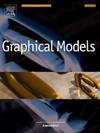通过基元识别从大规模点云构建语义分割
IF 2.2
4区 计算机科学
Q2 COMPUTER SCIENCE, SOFTWARE ENGINEERING
引用次数: 0
摘要
以大分辨率或大尺度对物体进行建模,会给数据的存储和处理带来挑战,并且需要高效的结构。在城市环境建模方面,我们面临着这两个问题:采集的三维数据以地理尺度进行扩展,而具有历史价值的建筑物的数字化可能特别密集。因此,在为进一步的需求(如可视化、模拟)导出其他表征(如表面或体积网格)之前(或同时),尽可能地利用从采集中获得的点云是至关重要的。在本文中,我们介绍了在处理城市区域三维数据以生成城市数字孪生语义模型方面所做的工作。具体来说,我们的重点是识别代表城市场景的点云中的形状基元(如平面、圆柱、球体),主要应用是将其语义分割为墙壁、屋顶、街道、圆顶、拱顶、拱门等。在这一扩展版本中,我们通过初步拆分建筑点云和简化管道,将该方法推广到管理整个城市。我们还利用塔林市的基准数据集(47,000 栋建筑)、瓦伊兴根市的部分数据集(170 栋建筑)以及意大利卡塔尼亚和马泰拉的案例研究(4 栋高分辨率建筑)进行了全面实验。结果表明,我们的方法成功地处理了相当规模的点云,无论是高分辨率勘测还是大面积覆盖。在这两种情况下,它对输入噪声和异常值都很稳健,但对不均匀的采样密度很敏感。本文章由计算机程序翻译,如有差异,请以英文原文为准。
Building semantic segmentation from large-scale point clouds via primitive recognition
Modelling objects at a large resolution or scale brings challenges in the storage and processing of data and requires efficient structures. In the context of modelling urban environments, we face both issues: 3D data from acquisition extends at geographic scale, and digitization of buildings of historical value can be particularly dense. Therefore, it is crucial to exploit the point cloud derived from acquisition as much as possible, before (or alongside) deriving other representations (e.g., surface or volume meshes) for further needs (e.g., visualization, simulation). In this paper, we present our work in processing 3D data of urban areas towards the generation of a semantic model for a city digital twin. Specifically, we focus on the recognition of shape primitives (e.g., planes, cylinders, spheres) in point clouds representing urban scenes, with the main application being the semantic segmentation into walls, roofs, streets, domes, vaults, arches, and so on.
Here, we extend the conference contribution in Romanengo et al. (2023a), where we presented our preliminary results on single buildings. In this extended version, we generalize the approach to manage whole cities by preliminarily splitting the point cloud building-wise and streamlining the pipeline. We added a thorough experimentation with a benchmark dataset from the city of Tallinn (47,000 buildings), a portion of Vaihingen (170 building) and our case studies in Catania and Matera, Italy (4 high-resolution buildings). Results show that our approach successfully deals with point clouds of considerable size, either surveyed at high resolution or covering wide areas. In both cases, it proves robust to input noise and outliers but sensitive to uneven sampling density.
求助全文
通过发布文献求助,成功后即可免费获取论文全文。
去求助
来源期刊

Graphical Models
工程技术-计算机:软件工程
CiteScore
3.60
自引率
5.90%
发文量
15
审稿时长
47 days
期刊介绍:
Graphical Models is recognized internationally as a highly rated, top tier journal and is focused on the creation, geometric processing, animation, and visualization of graphical models and on their applications in engineering, science, culture, and entertainment. GMOD provides its readers with thoroughly reviewed and carefully selected papers that disseminate exciting innovations, that teach rigorous theoretical foundations, that propose robust and efficient solutions, or that describe ambitious systems or applications in a variety of topics.
We invite papers in five categories: research (contributions of novel theoretical or practical approaches or solutions), survey (opinionated views of the state-of-the-art and challenges in a specific topic), system (the architecture and implementation details of an innovative architecture for a complete system that supports model/animation design, acquisition, analysis, visualization?), application (description of a novel application of know techniques and evaluation of its impact), or lecture (an elegant and inspiring perspective on previously published results that clarifies them and teaches them in a new way).
GMOD offers its authors an accelerated review, feedback from experts in the field, immediate online publication of accepted papers, no restriction on color and length (when justified by the content) in the online version, and a broad promotion of published papers. A prestigious group of editors selected from among the premier international researchers in their fields oversees the review process.
 求助内容:
求助内容: 应助结果提醒方式:
应助结果提醒方式:


